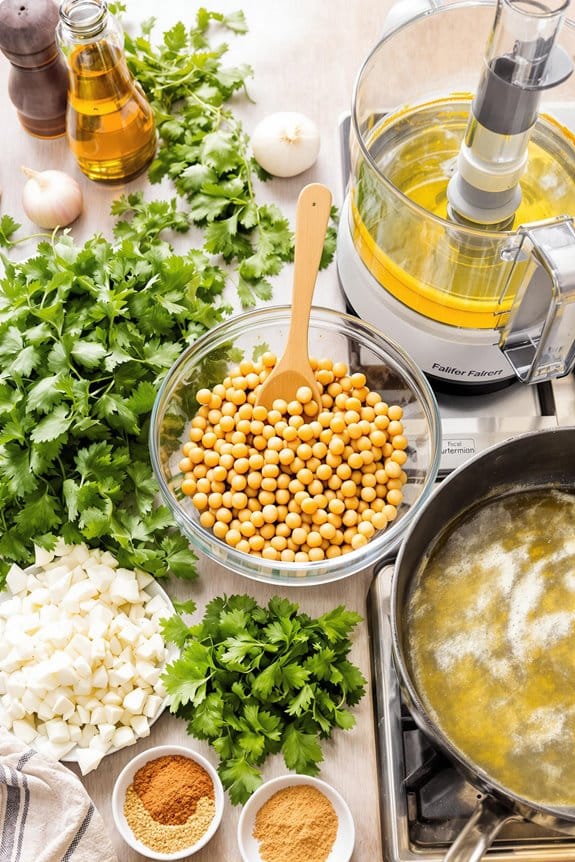A Middle Eastern street food feast is an enticing blend of flavors, textures, and traditions that reflects the region’s rich culinary heritage. You’ll find dishes like falafel, made from ground chickpeas, and hummus, made with tahini and garlic, both showcasing the depth of local ingredients. Freshly baked pita bread, grilled chicken skewers, vibrant salads, and colorful dips come together to create a communal dining experience that invites sharing. The inclusion of pickled vegetables enhances the meal’s tanginess, while fresh herbs elevate the overall flavor profile. Exploring each dish offers insight into the region’s culture and culinary artistry, so there’s much more to discover.
History
Exploring the history of Middle Eastern street food reveals a rich tapestry of culinary traditions shaped by diverse cultures and trade routes. From bustling markets in ancient cities to modern-day food stalls, each dish tells a story of migration, trade, and adaptation.
The region’s strategic location, at the crossroads of Europe, Asia, and Africa, has long made it a melting pot of flavors and influences. As you wander through the streets of cities like Istanbul, Cairo, and Beirut, you’ll notice how each local delicacy reflects its historical roots.
For instance, shawarma, believed to have originated from the Ottoman Empire, showcases the blend of spices and cooking techniques that evolved over centuries. Similarly, falafel, which has roots in ancient Egypt, has become a staple enjoyed across the region, representing both street food culture and culinary innovation.
The introduction of ingredients like chickpeas, spices, and herbs highlights how trade routes facilitated the exchange of not just goods, but also culinary ideas. This dynamic history of Middle Eastern street food illustrates the enduring connections between cultures and the way food continues to bring people together, celebrating both shared traditions and unique identities.
Recipe Cooking Steps
Middle Eastern street food is a vibrant celebration of flavors and textures, often enjoyed on bustling city streets or at lively markets. One popular dish that captures the essence of this culinary tradition is falafel, a deep-fried ball or patty made from ground chickpeas or fava beans, herbs, and spices. This vegetarian delight isn’t only delicious but also packed with protein, making it a favorite among both vegetarians and meat-lovers alike. Served in pita bread with fresh vegetables and tahini sauce, falafel has become a beloved staple around the world.
To make authentic falafel at home, it’s essential to use dry chickpeas instead of canned ones, as the former yields a better texture and flavor. Soaking the chickpeas overnight allows them to soften and blend well with the spices and herbs. The key to achieving that perfect crispy exterior while maintaining a moist interior lies in the frying technique. With the right ingredients and a bit of patience, you can whip up a batch of falafel that rivals your favorite street vendor.
Ingredients:
- 1 cup dry chickpeas
- 1 small onion, chopped
- 2 cloves garlic, minced
- 1/4 cup fresh parsley, chopped
- 1/4 cup fresh cilantro, chopped
- 1 teaspoon ground cumin
- 1 teaspoon ground coriander
- 1/2 teaspoon baking powder
- Salt and pepper to taste
- Vegetable oil for frying
To prepare the falafel, begin by soaking the dry chickpeas in water overnight, then drain them well. In a food processor, combine the soaked chickpeas, chopped onion, minced garlic, parsley, cilantro, cumin, coriander, baking powder, salt, and pepper. Pulse the mixture until it forms a coarse dough, being careful not to over-process.
Shape the mixture into small balls or patties and refrigerate for about 30 minutes. Heat vegetable oil in a deep pan over medium-high heat and fry the falafel until golden brown and crispy on all sides, about 3-4 minutes. Remove them from the oil and drain on paper towels before serving.
When cooking falafel, remember that the oil temperature is vital for achieving the perfect crispiness. If the oil is too hot, the falafel will brown too quickly on the outside while remaining raw inside. Conversely, if the oil isn’t hot enough, they may absorb too much oil and become greasy.
Additionally, feel free to experiment with spices and herbs to customize the flavor to your liking. Serve your falafel with fresh toppings like shredded lettuce, diced tomatoes, cucumbers, and a drizzle of tahini or yogurt sauce for an authentic Middle Eastern experience.
Step 1. Prepare Fresh Pita Bread
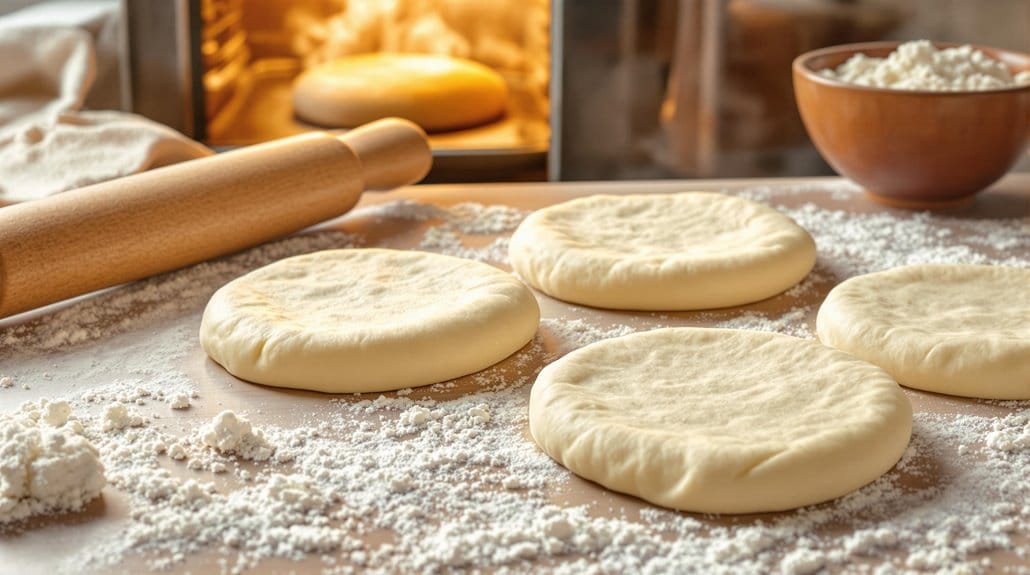
Often, making fresh pita bread at home is simpler than you might think. With just a few ingredients and some patience, you can create soft, fluffy pockets that are perfect for any Middle Eastern feast.
Here’s a quick guide to help you get started:
- Mix the Dough: Combine warm water, yeast, and sugar in a bowl. Let it sit until frothy, then mix in flour and salt. Knead the dough until it’s smooth and elastic.
- Let it Rise: Place the dough in a greased bowl, cover it with a damp cloth, and let it rise in a warm spot for about an hour. It should double in size, showing you that the yeast is doing its job.
- Shape and Bake: Punch down the dough, divide it into balls, and roll each ball into a flat circle. Preheat your oven with a baking stone or tray inside. Bake the circles for about 5-7 minutes until they puff up and get a light golden color.
Once they’re done, enjoy your fresh pita bread warm, knowing you’ve crafted a delightful addition to your meal.
It’s a rewarding experience!
Step 2. Mix Ingredients for Hummus
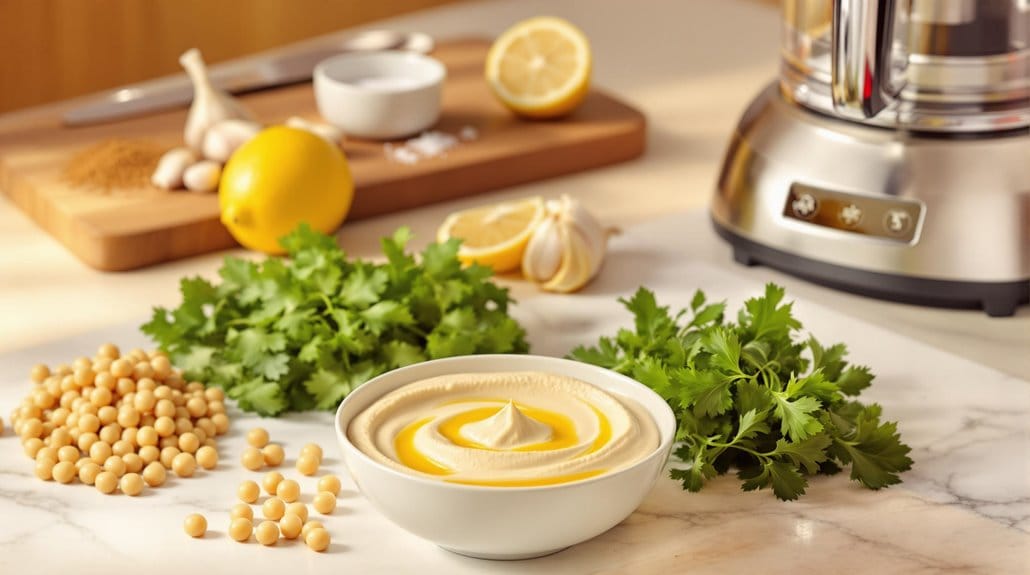
Hummus, a creamy and flavorful dip, is a staple of Middle Eastern cuisine that’s easy to whip up at home. To create your own delicious batch, start with the basics: you’ll need canned chickpeas, tahini, garlic, lemon juice, olive oil, and salt.
Drain and rinse the chickpeas, then place them in a food processor. This will serve as the foundation for your hummus.
Next, add about a quarter cup of tahini, which gives the dip its rich, nutty flavor. Toss in two cloves of garlic, adjusting to your taste preference, and the juice of one lemon for a zesty kick. Drizzle in a couple of tablespoons of olive oil; this will enhance the smoothness of your hummus. Sprinkle in a pinch of salt to elevate the flavors.
Now, blend the mixture until it’s smooth and creamy. If the texture feels too thick, add a little water, one tablespoon at a time, until you reach your desired consistency.
Finally, taste your hummus, adjusting the seasoning as needed. Serve it with fresh pita bread or vegetables, and enjoy the authentic flavors of the Middle East right in your kitchen!
Step 3. Grill Marinated Chicken Skewers
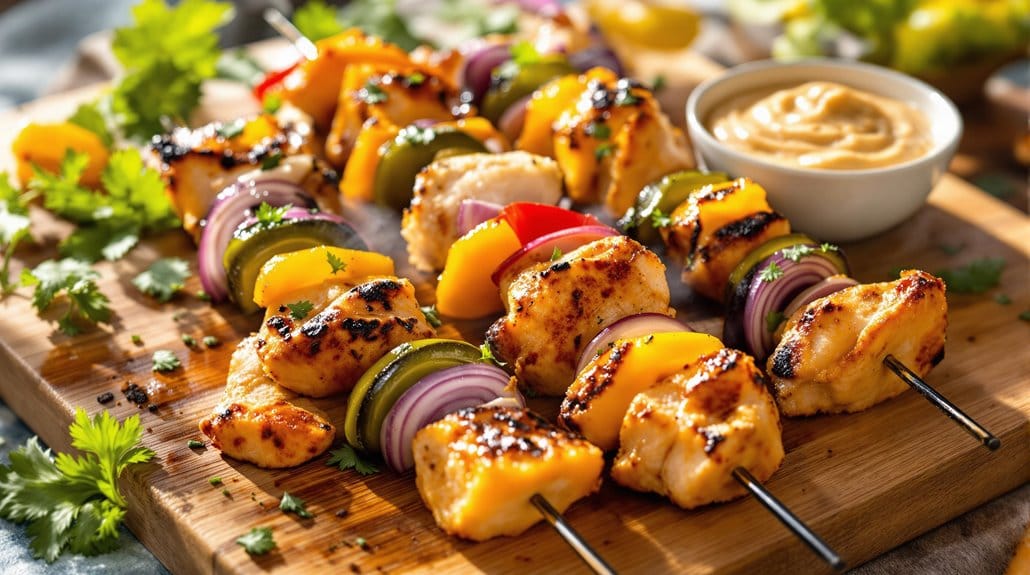
After enjoying a flavorful dip like hummus, you might want to complement it with some delicious grilled marinated chicken skewers.
These skewers aren’t only simple to prepare but also packed with robust flavors that reflect Middle Eastern culinary traditions.
Follow these steps to create the perfect dish.
1. Marinate the Chicken: Start by cutting boneless chicken thighs into cubes and marinating them in a mixture of olive oil, lemon juice, garlic, and spices like cumin and paprika.
Let the chicken soak up those flavors for at least an hour, or overnight if you have the time.
2. Prepare the Skewers: Thread the marinated chicken onto soaked wooden skewers or metal ones, ensuring the pieces are evenly spaced for proper cooking.
You can also add vegetables like bell peppers and onions for extra color and flavor.
3. Grill to Perfection: Preheat your grill to medium-high heat and cook the skewers for about 10-15 minutes, turning occasionally, until the chicken is cooked through and has those beautiful grill marks.
Once you’ve mastered these steps, you’ll have a delightful addition to any Middle Eastern feast!
Step 4. Assemble the Street Food Platter
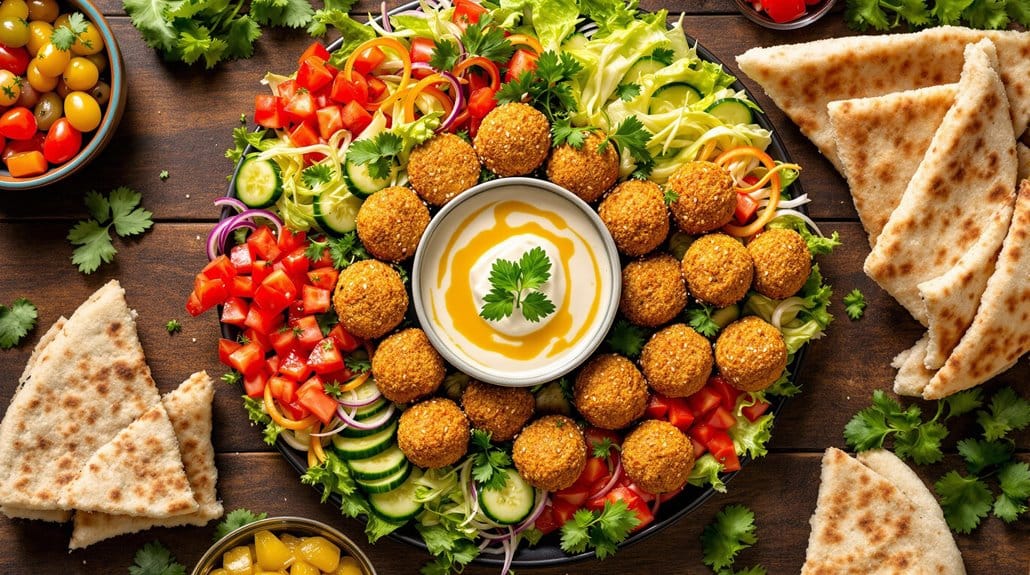
To create a vibrant street food platter, gather all your delicious components and arrange them artfully on a large serving board or platter.
Start with the grilled marinated chicken skewers you’ve prepared, placing them prominently in the center, as they’re sure to catch everyone’s attention.
Next, add a generous portion of fluffy pita bread, either whole or cut into triangles, to provide a perfect vehicle for all those tasty bites.
Surround the chicken and pita with a variety of colorful dips, like creamy hummus and tangy baba ghanoush. These dips not only add flavor but also create a visually appealing contrast.
You can also include a fresh tabbouleh salad, showcasing the vibrant greens and tomatoes, which will bring freshness to the mix.
Finally, consider adding some pickled vegetables, such as turnips or carrots, for an extra zing. These little bursts of flavor help round out the platter, inviting your guests to explore.
As you assemble your platter, think about balance and color, ensuring each component shines.
This street food feast isn’t just a meal; it’s an experience that encourages sharing, conversation, and enjoyment.
Step 5. Garnish With Fresh Herbs
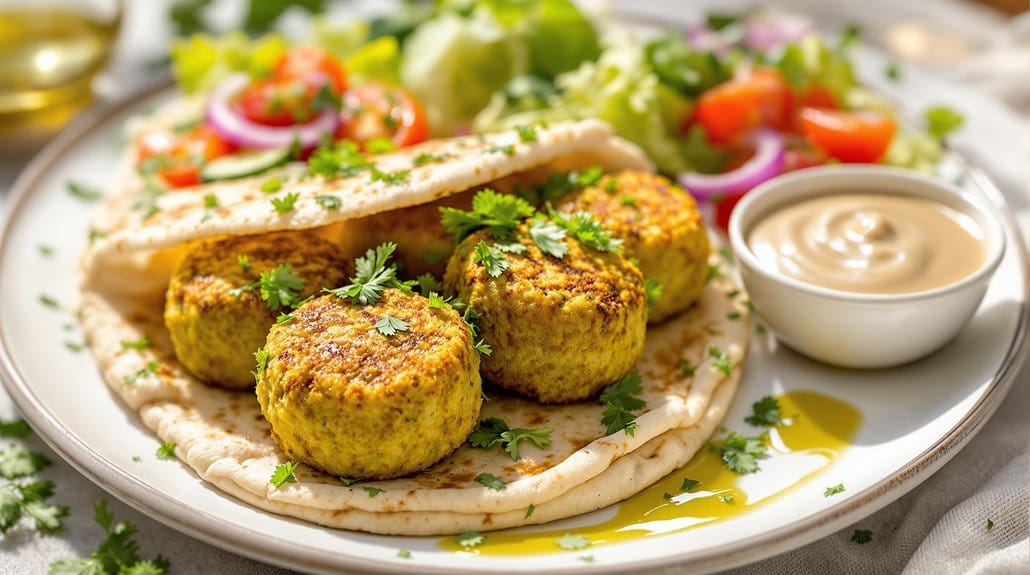
Fresh herbs can elevate your Middle Eastern street food platter, adding a burst of flavor and a pop of color. Not only do they enhance the taste, but they also create an inviting presentation that’s sure to impress your guests.
Here’s how to incorporate fresh herbs effectively:
- Chop Fresh Parsley or Cilantro: Finely chop fresh parsley or cilantro and sprinkle it generously over your dishes. These herbs provide brightness and a fresh taste that pairs well with dishes like falafel, hummus, and grilled meats.
- Add Mint Leaves: Fresh mint brings a cooling contrast to spicy flavors. You can either chop the leaves or leave them whole as a garnish. Placing mint atop your tabbouleh or yogurt sauce adds a delightful visual and flavor twist.
- Use Dill for a Unique Touch: Dill isn’t the most common herb in Middle Eastern cooking, but it’s a wonderful addition. It complements seafood dishes beautifully. A sprinkle of fresh dill can enhance the flavor profile of your grilled shrimp or fish kebabs.
New Recipe
- Pepperoni and Hot Honey PizzaTry the tantalizing twist of pepperoni pizza with hot honey, where sweet meets heat—how will it transform your taste buds?
Final Thoughts
Middle Eastern street food offers a vibrant tapestry of flavors and experiences that can elevate any culinary adventure. As you explore this remarkable cuisine, you’ll discover rich traditions, diverse ingredients, and a sense of community that permeates every dish. From the tantalizing aroma of shawarma sizzling on a grill to the colorful array of fresh salads and dips, each bite tells a story steeped in culture.
Sampling street food isn’t just about satisfying your hunger; it’s an opportunity to connect with local vendors and fellow food enthusiasts. You might find yourself sharing laughter and stories over a plate of falafel or a warm pita filled with grilled meats. The communal aspect of enjoying street food really adds to its charm, making every meal a shared experience.
Remember that each region offers its own unique takes on classic dishes, so don’t hesitate to try something new. Whether you’re indulging in a spicy kebab or a sweet dessert like baklava, each experience enhances your understanding of Middle Eastern culinary artistry.
Ultimately, diving into this world of street food won’t only tantalize your taste buds but also create lasting memories you’ll cherish long after your adventure ends.
Bottom Line
To summarize, creating a Middle Eastern street food feast at home is a rewarding culinary adventure that highlights the rich flavors and traditions of the region. By preparing fresh pita, vibrant hummus, and perfectly grilled chicken skewers, you not only celebrate the diverse tastes but also bring a piece of the community’s culture to your table. As you garnish with fresh herbs, remember that sharing this meal with friends and family fosters connection and appreciation for the culinary arts. Enjoy every bite!

